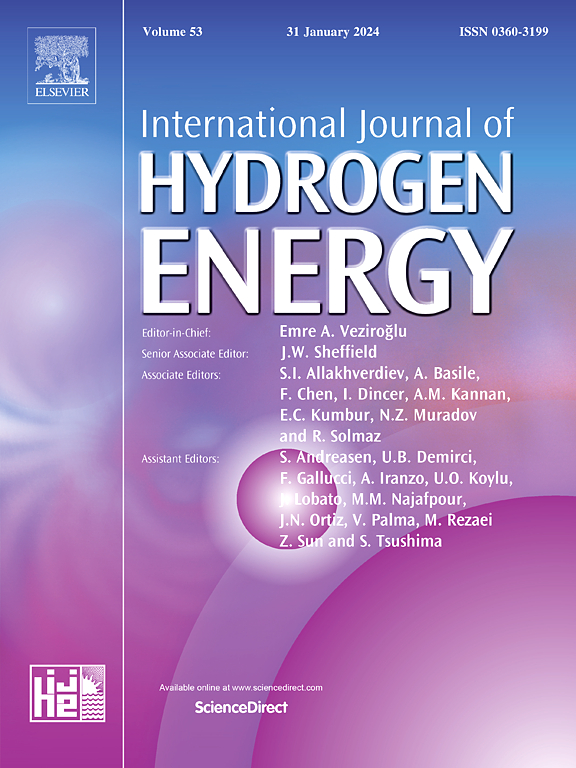Synergistic effects of SO42− /PO43− modification and Fe-loading on NH3-SCR activity in surface-engineered rare earth concentrate catalysts
IF 8.1
2区 工程技术
Q1 CHEMISTRY, PHYSICAL
引用次数: 0
Abstract
Bayan Obo rare earth concentrate (REC), naturally rich in Ce and low in transition metals, exhibits high stability and poison resistance, making it promising for NH3-SCR. The REC was first modified with H2SO4 (S) or H3PO4 (P). Optimizing acid concentration revealed that 6 mol/L H2SO4 and 4 mol/L H3PO4 yielded catalysts with the best SCR activity. To broaden the temperature window and enhance activity, acid-treated REC(REC-S/P) was further modified with Fe via impregnation, creating Fe2O3/REC-(S/P) catalysts. Studies on varying Fe/Ce ratios showed an optimal loading (Fe/Ce = 0.8) significantly expanded the operating temperature range and improved N2 selectivity. These catalysts achieved >90 % NOx conversion between 325 and 375 °C. Iron loading critically enhanced SCR activity by improving redox properties and increasing available acidic sites. In-situ IR studies explored adsorption (NH3, NO, O2) and reaction pathways. Adsorbed NO was oxidized by surface Fe3+ to form –NO2- and –NO3- species, primarily via the Langmuir-Hinshelwood (L-H) mechanism. At higher temperatures, adsorbed NH3 species activated by Fe3+ formed amide (NH2). Crucially, this NH2 on Fe2O3/REC-(S/P) could be oxidized to N2O, predominantly through the Eley-Rideal (E-R) mechanism.
SO42−/PO43−改性和fe负载对表面工程稀土精矿催化剂NH3-SCR活性的协同效应
巴彦鄂博稀土精矿(REC)天然富含Ce,过渡金属含量低,具有较高的稳定性和抗毒性,在NH3-SCR中具有广阔的应用前景。首先用H2SO4 (S)或H3PO4 (P)对REC进行改性。酸浓度优化后,6 mol/L H2SO4和4 mol/L H3PO4催化剂的SCR活性最佳。为了拓宽温度窗口,提高活性,对酸处理的REC(REC-S/P)进行了Fe浸渍改性,制备了Fe2O3/REC-(S/P)催化剂。对不同Fe/Ce比值的研究表明,当Fe/Ce = 0.8时,最佳负载显著扩大了操作温度范围,提高了氮气选择性。这些催化剂在325至375°C之间实现了90%的NOx转化率。铁负载通过改善氧化还原性能和增加可用的酸性位点来增强SCR活性。原位IR研究了NH3, NO, O2的吸附和反应途径。吸附的NO被表面Fe3+氧化生成- no2 -和- no3 -,主要通过Langmuir-Hinshelwood (L-H)机制。在较高的温度下,被Fe3+活化的NH3物质形成酰胺(NH2)。关键是,Fe2O3/REC-(S/P)上的NH2可以主要通过Eley-Rideal (E-R)机制氧化成N2O。
本文章由计算机程序翻译,如有差异,请以英文原文为准。
求助全文
约1分钟内获得全文
求助全文
来源期刊

International Journal of Hydrogen Energy
工程技术-环境科学
CiteScore
13.50
自引率
25.00%
发文量
3502
审稿时长
60 days
期刊介绍:
The objective of the International Journal of Hydrogen Energy is to facilitate the exchange of new ideas, technological advancements, and research findings in the field of Hydrogen Energy among scientists and engineers worldwide. This journal showcases original research, both analytical and experimental, covering various aspects of Hydrogen Energy. These include production, storage, transmission, utilization, enabling technologies, environmental impact, economic considerations, and global perspectives on hydrogen and its carriers such as NH3, CH4, alcohols, etc.
The utilization aspect encompasses various methods such as thermochemical (combustion), photochemical, electrochemical (fuel cells), and nuclear conversion of hydrogen, hydrogen isotopes, and hydrogen carriers into thermal, mechanical, and electrical energies. The applications of these energies can be found in transportation (including aerospace), industrial, commercial, and residential sectors.
 求助内容:
求助内容: 应助结果提醒方式:
应助结果提醒方式:


